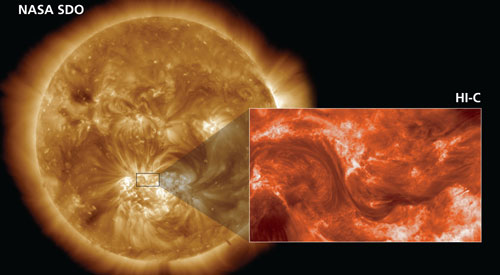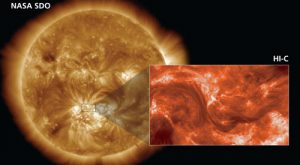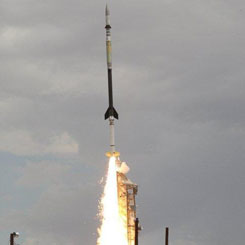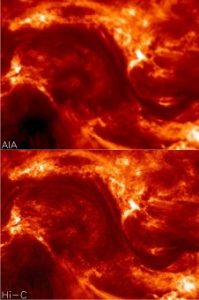
Stunning new images from Hi-C, the highest resolution telescope to observe the solar corona, have been released. These images are approximately 5 times more detailed than the Atmospheric Imaging Array on NASA’s SDO mission, and can resolve features in the solar atmosphere down to a size of about 135 mile. Images were taken at a rate of around 1 every 5 seconds for about 5 minutes.
Dr Robert Walsh, University Director of Research at UCLan, said: “These first images taken by the Hi-C camera are truly awe-inspiring and have surpassed our expectations.”
“Findings from the Hi-C Mission will help us to understand the outer atmosphere of the Sun, learn more about the electrified gases that erupt from it along with the mechanisms that generate the energy it releases; all of which have knock on effects on Earth.”
The High-Resolution Coronal Imager instrument, or Hi-C, was launched successfully on the 11th July 2012 aboard a Black Brunt sounding rocket from the White Sands Missile Range in New Mexico. The instrument flew for around 10 minutes, spending about half of that time taking high-resolution images of the solar corona in extreme ultraviolet light at a rate of around one every 5 seconds.
The project was led by NASA’s Marshall Space Flight Center, but included staff from the School of Computing, Engineering, and Physical Sciences at UCLan – and the JHI in particular. Other key partners were the University of Alabama at Huntsville, Smithsonian Astrophysical Observatory, and the Lebedev Physical Institute of the Russian Academy of Sciences.
The high-resolution images were made possible because of a set of innovations on Hi-C’s optics array. The telescope includes some of the finest mirrors ever made for space-based instrumentation. The increase in resolution of the images captured by Hi-C is similar to making the transition in television viewing from a cathode ray tube TV to high definition TV.
During its brief ten minute flight outside the Earth’s atmosphere, Hi-C focused on a large active region on the Sun near sunspot NOAA 1520 located close to the centre of the solar disc as viewed from Earth. Hi-C’s resulting high resolution snapshots reveal detailed tangles of magnetic field, channeling the electrified gases (plasma) into a range of complex structures.
Dr Walsh commented, “We are now able to analyse structural aspects of the Sun at a level of complexity we’ve never been able to achieve before. The image quality is comparable to looking at a reflection in a steamed up mirror and then wiping it clean to reveal the true detail”
Dr. Jonathan Cirtain, NASA Marshall Space Flight Center Senior Heliophysicist, added: “We had the right instrument and launched at the right time. Because of the intense solar activity we’re seeing right now, we were able to clearly focus on a sizeable, active sunspot and achieve our imaging goals.”
Barbara Giles, director for NASA’s Heliophysics Division in Washington, said: “These revolutionary images of the Sun demonstrate the key aspects of NASA’s sounding rocket program, namely the training of the next generation of principal investigators, the development of new space technologies, and scientific advancements.”
